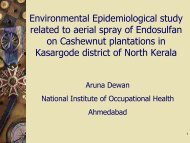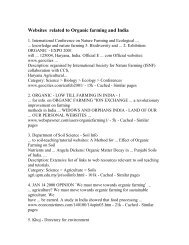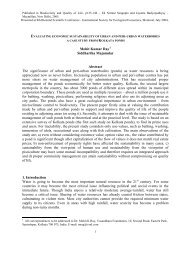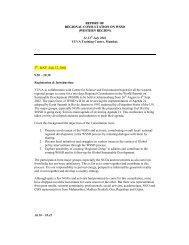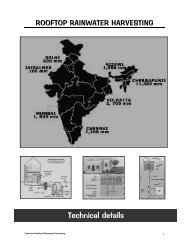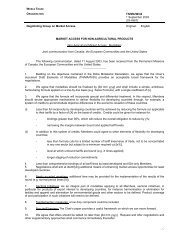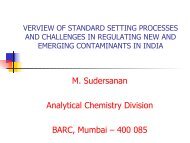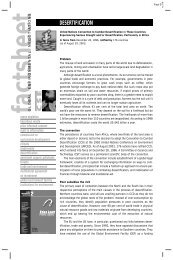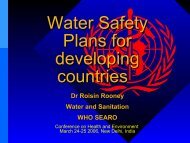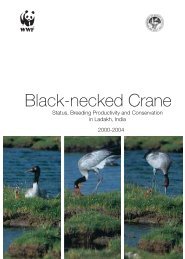Reviving a Water Heritage: - Rainwater Harvesting
Reviving a Water Heritage: - Rainwater Harvesting
Reviving a Water Heritage: - Rainwater Harvesting
Create successful ePaper yourself
Turn your PDF publications into a flip-book with our unique Google optimized e-Paper software.
interesting clues regarding popular perception about the TWHS and/or modern piped water<br />
supply and their readiness to pay for either or both of these systems.<br />
Results<br />
Drawing upon available documentation on TWHS and extensive field surveys in the broad<br />
ecological zones of the Thar Desert and Central Highlands, it is obvious that TWHS not only<br />
vary substantially in terms of technology and management, but also their functioning depends<br />
crucially on the local discrete environment. Keeping these local specificities in view the<br />
potential of selected systems in terms of long-term sustainability can be described in brief, as<br />
follows:<br />
Bavdis in Southwestern Madhya Pradesh: These exist in huge numbers. But, mainly due to<br />
their typically small size and limited storage capacity, these are probably not the best options<br />
for meeting community water needs. However, as observed by the hydro geologists and<br />
water engineers, it is possible to deepen existing talavs and dig new ones that, in turn, would<br />
recharge bavdis. In Dhababavdi (Barwani district) the currently functioning two bavdis serve<br />
a limited purpose and, clearly, cannot address the water scarcity problem of the entire village.<br />
Wells in Western Rajasthan: Wells as TWHS in the western parts of Rajasthan have<br />
continued to prove useful even during summer months in the driest geoclimatic region of<br />
India. Unlike bavdis, wells are extensively used by the rural communities and are well<br />
maintained. All the wells visited in this region during the peak summer season, had good<br />
supply of water and the local perception about its quality was positive. An important hydro<br />
geological characteristic of the wells surveyed was that the structures had been linked to<br />
underground perennial streams/channels. Also, these wells had been built with reference to<br />
the surrounding nadis (TWHS by themselves) so as to receive water recharged through them.<br />
Such ingenious selection of location and construction of the structures ensured a steady<br />
supply of water in the wells. These wells hold much potential to be revived and modernized.<br />
One effective approach would be to desilt, deepen and widen the concerned nadis; this will<br />
ensure a substantial increase in availability of water in the wells, which may be stored for a<br />
long period of time. These structures are also viable options in these regions where piped<br />
water system is most likely to fail due to very low groundwater tables.<br />
Talavs in Kutch, Gujarat: Almost all parts of the Kutch region have suffered substantial<br />
groundwater depletion and salinity ingress. High incidence of poor groundwater bearing<br />
formations has resulted in severe water crisis in the region. Talavs certainly remain an<br />
important solution to the water problem in Kutch. In many villages visited, villagers<br />
considered water from local talavs to be of good quality and that water is available in them<br />
during prolonged spells of summer. The structures in the surveyed villages are unique<br />
examples of interconnected talavs, specially designed to prevent drinking water mingling with<br />
water in other talavs meant for washing or bathing purposes. In terms of size and capacity<br />
talavs are of large dimensions. These are in dire need of revival and modernization and can<br />
surely prove valuable in addressing the water shortage problem in Kutch region. Unlike the<br />
saline groundwater, talavs retain potable water and also recharge surrounding aquifers as<br />
also other TWHS like wells.<br />
<strong>Water</strong> Quality<br />
A commonly held observation disfavouring TWHS as potential sources of potable water<br />
concerns the ‘unprotected’ and ‘unsafe’ nature of the water. This important dimension of<br />
quality of water of TWHS must be taken into consideration in evaluating their potential. <strong>Water</strong><br />
samples from the surveyed TWHS were collected for chemical analyses. Of the seven water<br />
samples collected from individual TWHS, in all the cases the water was found suitable for<br />
drinking; the incidence of total dissolved solids (TDS) was within permissible limits.<br />
Bacteriological analyses of the water samples were also carried out in the laboratory following<br />
scientific instructions. These tests, however, indicated to the unsuitability of the water for<br />
drinking purposes due to the presence of very high concentrations of coliform bacteria.<br />
Irrespective of the fact that most villagers use the water of TWHS for drinking, cooking and<br />
other domestic purposes, these scientific tests indicate deficiencies in water quality. In most<br />
cases, as in the surveyed TWHS, quality of water can be upgraded substantially through cost-<br />
iii



